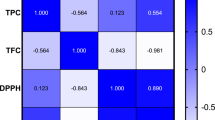Abstract
In presented study total phenolic contents, antioxidant capacities and their bioaccessibilities from cookies supplemented with oleaster flour were investigated. Oleaster flours (OFs) were produced using two different methods (peeled oleaster flour: POF and unpeeled oleaster flour: UPOF) from two different genotypes. OFs were used to replace wheat flour in the cookie formulation (control) at the levels of 5, 10, 15, 20 and 25% (w/w). According to the results, enrichment of OFs clearly increased total phenolic contents, antioxidant capacities and bioaccessibilities of cookies. The highest bioaccessible antioxidant capacities (ABTS, CUPRAC, and FRAP) of the samples were obtained from cookie samples enriched with 25% UPOF-1. In conclusion, the increases in phenolic contents, antioxidant capacities, and bioaccessibilities from cookies supplemented with OFs suggest the potential enhancement of beneficial health effect of cookie due to increased content of bioactive compounds present in oleaster flour.
Similar content being viewed by others
References
AACCI. Official methods of American Association of Cereal Chemists International, MN, USA (2000)
Acun S, Gul H. Effects of grape pomace and grape seed flours on cookie quality. Qual. Assur. Saf. Crop. 6: 81–88 (2014)
Ahmadiani A, Hosseiny J, Semnanian S, Javan M, Saeedi F, Kamalinejad M. Antinociceptive and anti-inflammatory effects of Elaeagnus angustifolia fruit extract. J. Ethnopharmacol. 72: 287–292 (2000)
Apak R, Guclu K, Ozyurek M, Celik SE. Mechanism of antioxidant capacity assays and the CUPRAC (cupric ion reducing antioxidant capacity) assay. Microchim Acta 160: 413–419 (2008)
Ayaz FA, Bertof E. Sugar and phenolic acid composition of stored commercial oleaster fruits. J. Food Compost. Anal. 14: 505–511 (2001)
Bailey LH, Bailey EZ, Hortus Third: A Concise Dictionary of Plants Cultivated in the United States and Canada, Macmillan, New York (1976)
Benzie IFF, Strain JJ. The ferric reducing ability of plasma (FRAP) as a measure of antioxidant power: The FRAP Assay. Anal. Biochem. 239: 70–76 (2002)
Bertagnolli SMM, Silveira MLR, Fogaça AO, Umann L, Penna ND. Bioactive compounds and acceptance of cookies made with guava peel flour. Food Sci. Technol. (Campinas) 34: 303–308 (2014)
Bouayed J, Hoffmann L, Bohn T. Total phenolics, flavonoids, anthocyanins and antioxidant activity following simulated gastro-intestinal digestion and dialysis of apple varieties: Bioaccessibility and potential uptake. Food Chem. 128: 14–21 (2011)
De Camargo AC, Vidal CMM, Canniatti-Brazaca SG, Shahidi F. Fortification of Cookies with Peanut Skins: Effects on the Composition, Polyphenols, Antioxidant Properties, and Sensory Quality. J. Agric. Food Chem. 62: 11228–11235 (2014)
Etcheverry P, Grusak MA, Fleige LE. Application of in vitro bioaccessibility and bioavailability methods for calcium, carotenoids, folate, iron, magnesium, polyphenols, zinc, and vitamins B6, B12, D, and E. Front. Physiol. 3: 1–22 (2012)
Farzaeia MH, Bahramsoltanic R, Abbasabadia Z, Rahi R. A comprehensive review on phytochemical and pharmacological aspects of Elaeagnus angustifolia L. J. Pharm Pharmacol. 67: 1467–1480 (2015)
Fernández-García E, Carvajal-Lérida I, Pérez-Gálvez A. In vitro bioaccessibility assessment as a prediction tool of nutritional efficiency. Nutr. Res. 29: 751–760 (2009)
Hamidpour R, Hamidpour S, Hamidpour M, Shahlari M, Sohraby M, Shahlari N, Hamidpour R. Russian olive (Elaeagnus angustifolia L): From a variety of traditional medicinal applications to its novel roles as active antioxidant, anti-inflammatory, anti-mutagenic and analgesic agent. J. Tradit. Complement. Med. 7: 24–29 (2017)
Jakobek L. Interactions of polyphenols with carbohydrates, lipids and proteins. Food Chem. 175: 556–567 (2015)
Liu YN, Jeong DH, Jung JH, Kim HS. Quality characteristics and antioxidant activities of cookies added with purple sweet potato powder. Korean J. Food Cook. Sci. 29: 275–281 (2013)
Manach C, Scalbert A, Morand C, Remesy C, Jimenez L. Polyphenols: Food sources and bioavailability. Am. J. Clin. Nutr. 79: 727–747 (2004)
Naczk M, Shahidi F. Extraction and analysis of phenolics in food. J. Chromatogr. A, 1054: 95–111 (2004)
Rodriguez H, Curiel JA, Landete JM, Rivas BI, Felipe FL, Cordoves CG, Mancheno JM, Munoz R. Food Phenolics and lactic acid bacteria. Int. J. Food Microbiol. 132: 79–90 (2009)
Sahan Y, Dundar AN, Aydin E, Kilci A, Dulger D, Kaplan FB, Gocmen D, Celik G. Characteristics of cookies supplemented with oleaster (Elaeagnus angustifolia L.) Flour. I physicochemical, sensorial and textural properties. J. Agric. Sci. 5: 160–168 (2013)
Sahan Y, Gocmen D, Cansev A, Celik G, Aydin E, Dundar AN, Dulger D, Kaplan HB, Kilci A, Gucer S. Chemical and techno-functional properties of flours from peeled and unpeeled oleaster (Elaeagnus angustifolia L.). J. Appl. Bot. Food Qual. 88: 34–41 (2015)
Sharma SK, Singh L, Singh S. A review on medicinal plants having antioxidant potential. Indian J. Res. Pharm. Biotechnol. 1: 395–404 (2013)
Turksoy S, Keskin S, Ozkay B, Ozkaya H. Effect of black carrot (Daucus carota L. ssp sativus var. atrorubens Alef.) fiber addition on the composition and quality characteristics of cookies. J. Food Agric. Environ. 9: 57–60 (2011)
Vitali D, Dragojevic IV, Sebecic B. Effects of incorporation of integral raw materials and dietary fibre on the selected nutritional and functional properties of biscuits. Food Chem. 114: 1462-1469 (2009)
Acknowledgements
The authors would like to thank The Scientific and Technological Research Council of Turkey (TUBITAK) for their financial support to this research project (Project No: TOVAG 110 O 060).
Author information
Authors and Affiliations
Corresponding author
Additional information
Publisher's Note
Springer Nature remains neutral with regard to jurisdictional claims in published maps and institutional affiliations.
Rights and permissions
About this article
Cite this article
Sahan, Y., Aydin, E., Dundar, A.I. et al. Effects of oleaster flour supplementation in total phenolic contents, antioxidant capacities and their bioaccessibilities of cookies. Food Sci Biotechnol 28, 1401–1408 (2019). https://doi.org/10.1007/s10068-019-00589-6
Received:
Revised:
Accepted:
Published:
Issue Date:
DOI: https://doi.org/10.1007/s10068-019-00589-6




